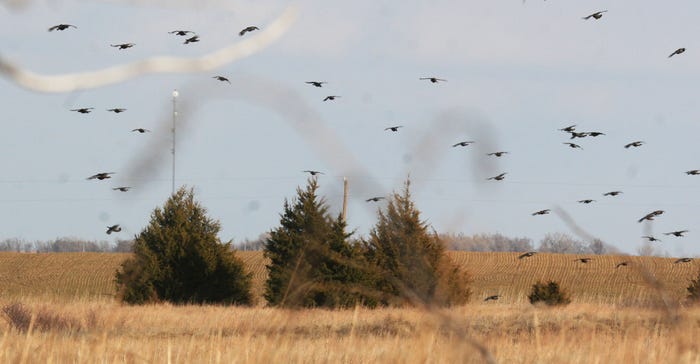March 26, 2020

A few years ago, it seemed wild turkeys were taking over Kansas. Populations grew exponentially. Farmers complained of crop damage. Winter flocks numbered high in the hundreds. Kansas had some of the longest seasons and highest bag limits in the nation.
Now, wild turkeys are few and far between over most of the state. Where I hunt in Butler County, the winter flock as gone from around 300 to maybe 50. Friends across Kansas report the same. Ditto in most other states.
The question is why?
“We don’t have any one reason anybody can put a finger on,” says Kent Fricke. Kansas Department of Wildlife, Parks and Tourism small game coordinator. “Overall, statewide, based on what we’ve seen the last 10 to 15 years, we have declining turkey populations. I’m not saying the outlook is bleak, but I’d call it concerning.”
In most areas, 2019 had the worst turkey reproduction in history. The “good-ol’ days” of wild turkey hunting didn’t last long.
All went so right, so early
The U.S.’s wild turkey comeback is one of the nation’s top conservation stories. The National Wild Turkey Federation had estimated about 30,000 birds were in the nation in the 1930s. A few years ago there were over 7 million. Historically, wild turkeys were found in what are now 39 states. Now, the only state without them is Alaska.
In his journal, “Hunting and Trading the Great Plains, 1859-1874,” J.R. Mead wrote of large turkey flocks in many areas. He bagged two fighting gobblers with one shot along Paradise Creek. A friend’s great-grandmother supported her family by live-trapping what seemed to be an endless supply of wild turkeys near Salina, Kan., in the early 1860s.
The birds were mostly extirpated from Kansas by 1900. It wasn’t until the 1960s that a few birds wandered up from Oklahoma, which was working to re-establish the birds.
Kansas soon started the same. Few things have worked as well.
Terry Funk, the state’s turkey biologist in the mid-1980s, said at the start of the state’s program it was hoped Kansas would someday support 7,500 wild turkeys. By 2000, there were probably individual counties with such numbers.
Trap and transplant efforts stocked new areas. Birds thrived in all kinds of habitats. Releases of three toms and nine hens turned into hundreds in a few years. A spring morning along stream through much of Kansas sounded like the wave as toms gobbled back and forth.
Wild turkey tail spin
Then, things started sliding. Summer surveys showed almost no reproduction last year. This spring’s season may have the fewest birds in decades.
“The concerning part is, we don’t have any data to say this is the low point,” Fricke says. “Not just in Kansas, but across much of the U.S.”
Jim Pittman, a regional biologist for the National Wild Turkey Federation, says weather conditions haven’t helped. The last three springs have had heavy rains that washed out nests. The record drought of 2011-12 left habitat thin and food for chicks scarce.
Still.
“It’s likely been due to multiple factors, and not just one,” Fricke says of the ongoing lack of good hatches. “Habitat quality can always be a problem. Predators are always factor on any wildlife. There’s predation on the nests and on adult birds.”
Fricke says disease can cause mortality, but it’s not usually widespread through the population.
With nests often having a dozen or more eggs, it’s possible Kansas turkeys could turn the ongoing decline around with a few years of good production.
The Kansas Department of Wildlife, Parks and Tourism has reduced spring limits from two toms to one in about all but northwest Kansas. The fall season, which allows the taking of hens, has been reduced from 3 ½ months and a limit of four birds to a few weeks and a limit of one bird.
“It’s gotten to where every one of those hens are pretty darn important right now,” Pittman says.
Hopefully the weather will cooperate, and those hens will pull off a good hatch and raise big broods.
How to help
For landowners interested in improving habitat, Fricke has recommendations.
Good brood-rearing habitat needs plenty of natural flowers and, well, weeds to attract the insects that make up nearly all of a chick’s diet. Any area that can be spared from herbicide and pesticide helps.
Programs such as buffer strips around crop fields can help turkeys and quail.
Selectively cutting a few trees in large forests allows sunlight to hit the forest floor, creating great brushy habitat.
Fire, used in moderation, is one of the best tools for helping turkeys and other birds. It kills cedars, encourages the growth of wildflowers and removes thick ground thatch that can be difficult for chicks to navigate.
“Even if you burn up a nest, those areas produce a lot of forbs,” Fricke says. “That’s a big improvement for other poults in that area.”
Pearce writes from Lawrence.
Read more about:
Wild TurkeysYou May Also Like




